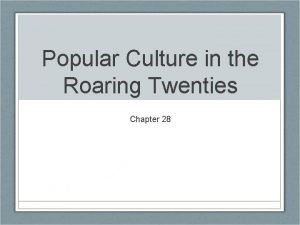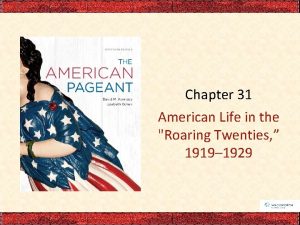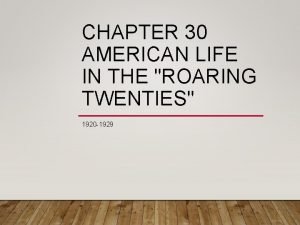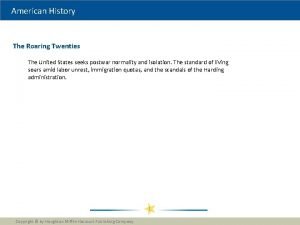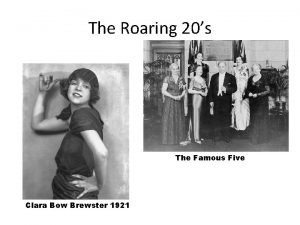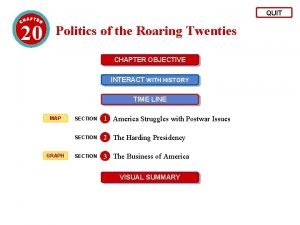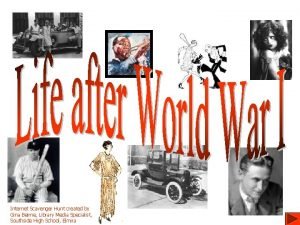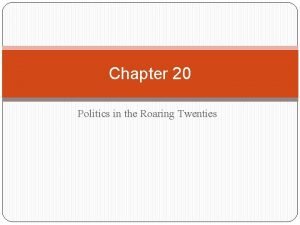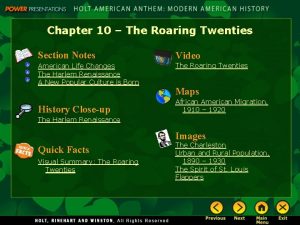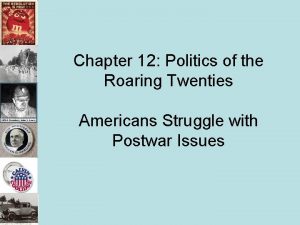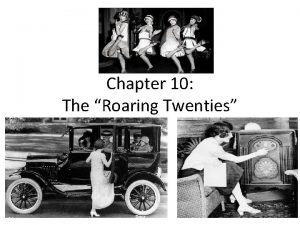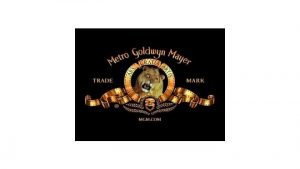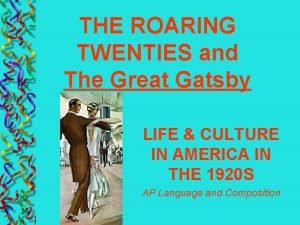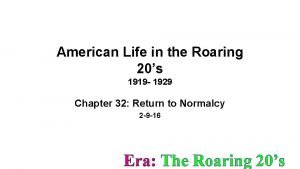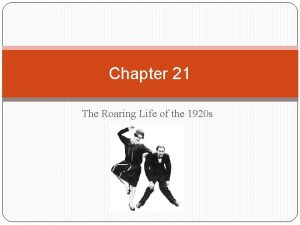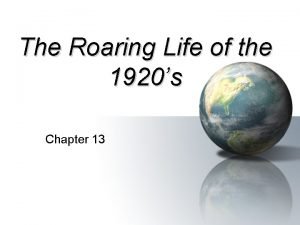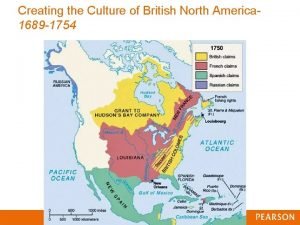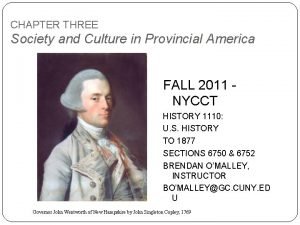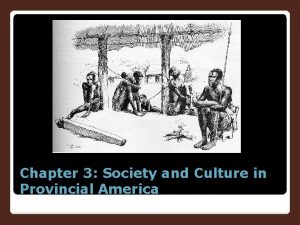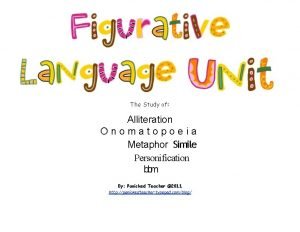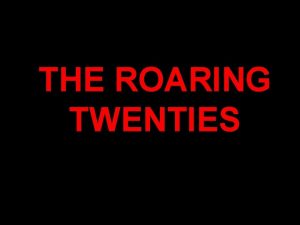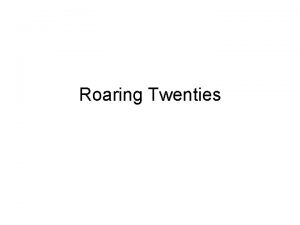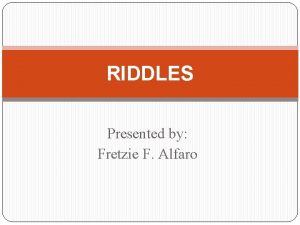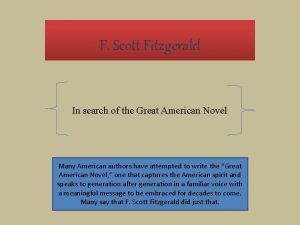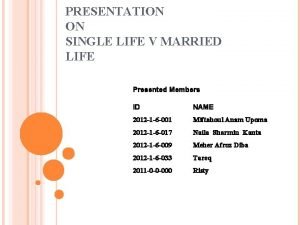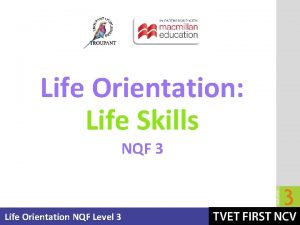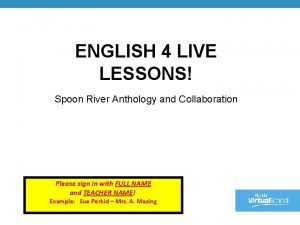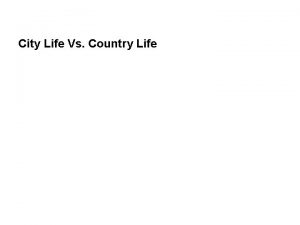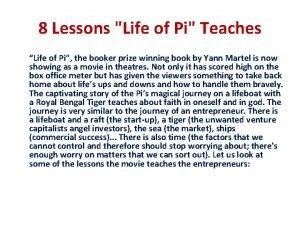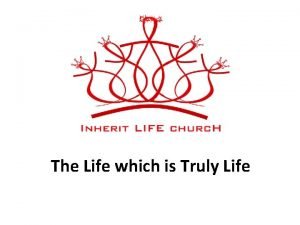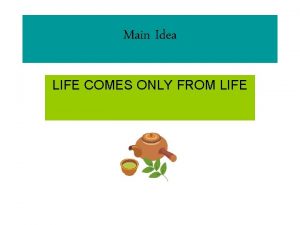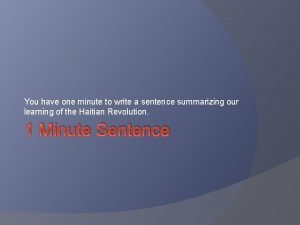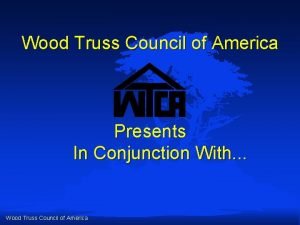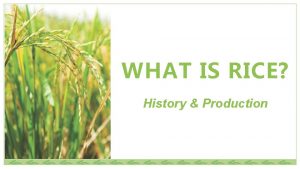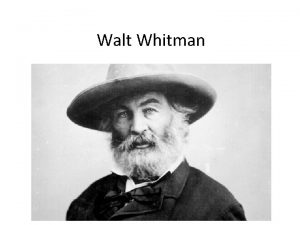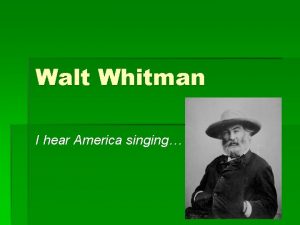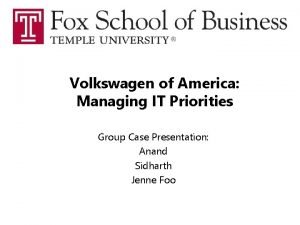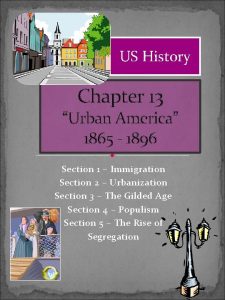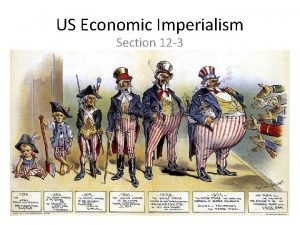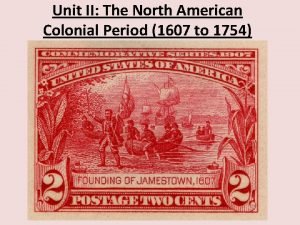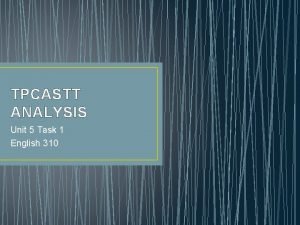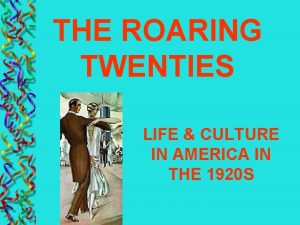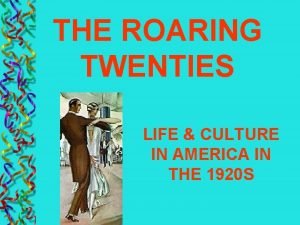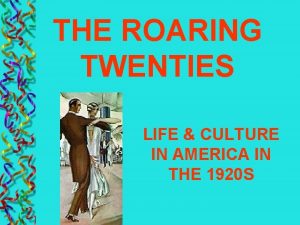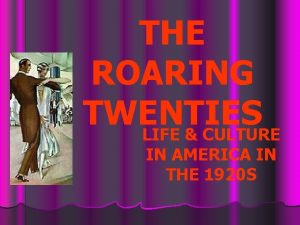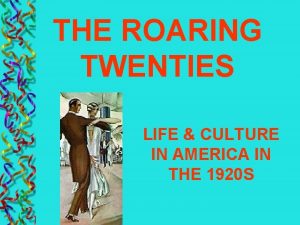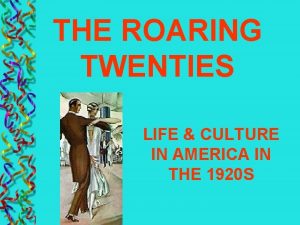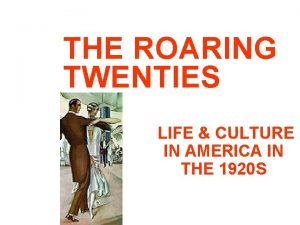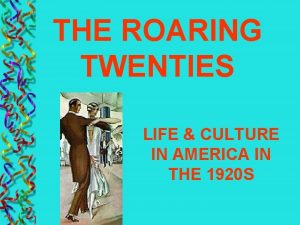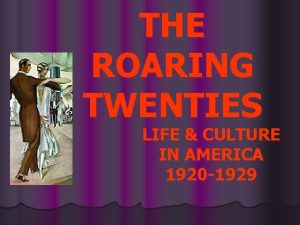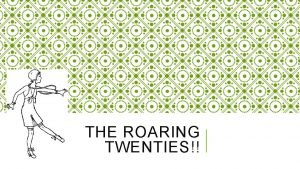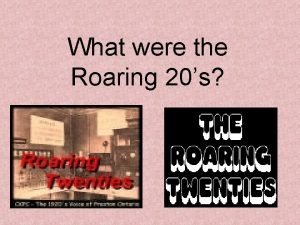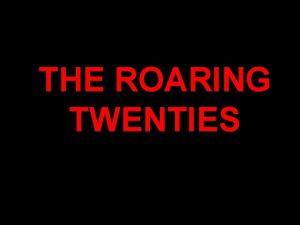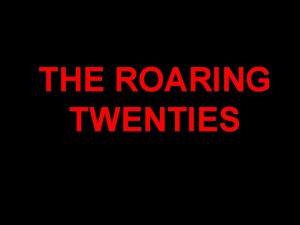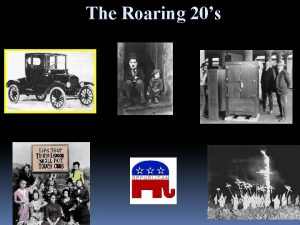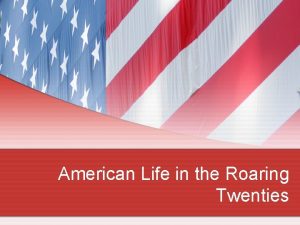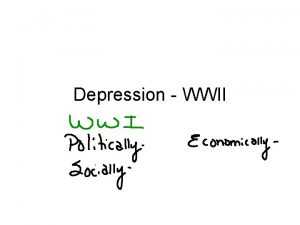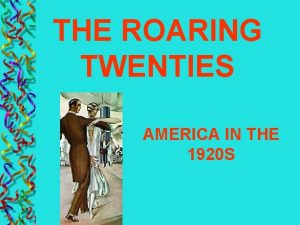1 THE ROARING TWENTIES LIFE CULTURE IN AMERICA
























































































































- Slides: 120

1 THE ROARING TWENTIES LIFE & CULTURE IN AMERICA IN THE 1920 S

Reasons for Prosperity in the 1920 s… Reason #1 -- Impact of the Automobile – Henry Ford developed the assembly line (parts can be made faster and can be made by unskilled workers) What impact did Ford’s assembly line have on the U. S. ? **Ford’s assembly line makes car production cheaper **Cars are much more affordable – no longer just toys for the wealthy **Gas station, restaurant, and tourism businesses boom and it becomes easy to live in rural areas Ford and his Model T

Reasons for Prosperity in the 1920 s… Reason #2 – The development of New Industries **widespread use of electricity allows for many new industries, jobs, and profits What are some of the new industries in the 1920 s? 1. The automobile industry 2. The Electrical Industry 3. Radio and Motion Picture Industries

Reasons for Prosperity in the 1920 s… Reasons #3 – More Efficient Production Techniques New techniques in manufacturing and industrial production (such as the assembly line) allow industry to be more efficient What is an assembly line? Workers stay in one place doing the same job, as products come to them on a conveyor belt

**Efficient Production Techniques make huge quantities of goods available and people have money to spend on them – It is a time of MASS CONSUMPTION!!!! Mass Consumption – (definition) A large amount of items are being produced, purchased, and used

President Warren Harding (1920 -1923) “A Return to Normalcy” –Harding’s campaign motto when he won the 1920 election: promises to get America back to normal after the war and to run a government less involved in business and foreign affairs (wants to end the postwar recession) Harding’s Presidency is most remembered for it’s scandals: Teapot Dome Scandal: Government officials accepted bribes from business men (money in exchange for government oil fields in Teapot Dome, Wyoming)

Teapot Dome Scandal Many of Harding’s political appointments took bribes and were suspected of serious crimes Harding’s friend (the Secretary of the Interior) convinced Harding to give his office control over the nation’s oil reserves. This man then leased the reserves to two companies for $360, 000 to do with as they pleased. This scandal shook the public’s trust in how the government was being run

President Calvin Coolidge 1923 -1929 "Stay Cool with Coolidge" • Took over after Harding's death • Committed to business • Laissez Faire approach to the economy • "Coolidge Prosperity" -- the economy improves under Coolidge The Kellogg-Briand Pact -- passed in 1928 during Coolidge's presidency. This was an agreement among nations to outlaw war except in self-defense. Nations agree to settle disputes through peaceful means and not through war. (Problem: there was no way to enforce the pact)

President Herbert Hoover (1929 -1933) • Promised to help end poverty and unequal distribution of wealth in the U. S. • Laissez faire government • Wanted to "help people help themselves" PROBLEM!!!!!! Hoover was President during the Stockmarket Crash in October of 1929 (Black Tuesday) --leading to the start of the Great Depression

CHANGING WAYS OF LIFE q During the 1920 s, urbanization continued to accelerate q For the first time, more Americans lived in cities than in rural areas q New York City was home to over 5 million people in 1920 q Chicago had nearly 3 million

URBAN VS. RURAL Cities were impersonal Farms were innocent q Throughout the 1920 s, Americans found themselves caught between urban and rural cultures q Urban life was considered a world of anonymous crowds, strangers, moneymakers, and pleasure seekers q Rural life was considered to be safe, with close personal ties, hard work and morals

Life in the 1920 s: Entertainment: – 1) 2) 3) 4) 5) Shorter working hours and higher wages gave Americans more spare time and more money for entertainment Radio – first radio station in Pittsburgh, PA in Nov. 1920 – only news at first – baseball and music broadcasted later Moving Picture Shows (“movies”) – all movies were silent films at first (had music but no talking) Ex. Charlie Chaplin, Mary Pickford, Clara Bow Sports –often called the “Golden Age of Sports” Music / Dance – the radio made music more popular Literature

Life in the 1920 s: Sports a) Babe Ruth – nicknamed “The Sultan of Swat” or “The Great Bambino” -most famous baseball player of the 20 s -played most of his career with the NY Yankees -hit 60 homeruns in 1927 (remained a record until 1961) -hit 714 career homeruns (remained a record nearly 40 years)

Life in the 1920 s: Music and Dance: • • • Jazz was the most popular music of the 20 s started in New Orleans Louis Armstrong was the most popular jazz musician of the 20 s George Gershwin was a popular composer – wrote “Rhapsody in Blue” http: //www. youtube. com/watch ? v=OSq_nwo. G 43 s&safe=activ e popular dances included: Charleston, Fox-trot, and Tango

Life in the 1920 s: Literature – Famous 1920 s authors include: • • F. Scott Fitzgerald – The Great Gatsby Sinclair Lewis – Main Street Ernest Hemingway – A Farewell to Arms Langston Hughes – Poem: “let American Be America Again”

Life in the 1920 s: Return of the Ku Klux Klan Revived in the 1920 s Membership: -1916 - 100, 000 -1924 - 2 million -1928 - 4 million - today- +/- 6, 000 • Attacked: - African Americans - Jews - Catholics - Immigrants

PROHIBITION q One example of the clash between city & farm was the passage of the 18 th Amendment in 1920 q This Amendment launched the era known as Prohibition q The new law made it illegal to make, sell or transport liquor Prohibition lasted from 1920 to 1933 when it was repealed by the 21 st Amendment

Life in the 1920 s: A. Prohibition Era (1919 -1933): 18 th Amendment (1919): prohibited the making, selling, or transportation of alcohol Volstead Act – law passed by Congress to enforce prohibition - ignored by most of cities on the east coast

Life in the 1920 s: Success of prohibition: -consumption of alcohol decreased -arrest for drunkenness decreased Why did Prohibition eventually fail? 1) Not enforced – some police depts. were corrupt, just didn’t care, or were scared of the gangsters 2) Most people didn’t take prohibition seriously – drank anyway

SUPPORT FOR PROHIBITION q Reformers had long believed alcohol led to crime, child & wife abuse, and accidents q Supporters were largely from the rural south and west q The church affiliated Anti. Saloon League and the Women’s Christian Temperance Union helped push the 18 th Amendment through

Poster supporting prohibition

Effects of Prohibition

SPEAKEASIES AND BOOTLEGGERS q Many Americans did not believe drinking was a sin q Most immigrant groups were not willing to give up drinking q To obtain liquor illegally, drinkers went underground to hidden saloons known as speakeasies q People also bought liquor from bootleggers who smuggled it in from Canada, Cuba and the West Indies

Moonshine • A spirit made secretly in home made stills. • Several hundred people a year died from this during the 1920 s. • In 1929 it is estimated that 700 million gallons of beer were produced in American homes.

Bootleggers • Getting illegal alcohol from the moonshiners to the speakeasies was the job of bootleggers. • Bootleggers drove souped up cars that could outrun most police vehicles. The men who drove them were daredevils who relished the chase and the money to be made transporting prohibited spirits. • After Prohibition, many of the men who drove as bootleggers came together to found the sport of racing.

Speakeasies • Secret saloon bars opened up in cellars and back rooms. • They had names like the ‘Dizzy Club’ and drinkers had to give a password or knock at the door in code to be let in. • Speakeasies sold ‘bootleg’ alcohol, smuggled into America from abroad. • Before Prohibition there were 15, 000 bars in New York. By 1926 there were 30, 000 speakeasies!

ORGANIZED CRIME Al Capone was finally convicted on tax evasion charges in 1931 q Prohibition contributed to the growth of organized crime in every major city q Chicago became notorious as the home of Al Capone – a famous bootlegger q Capone took control of the Chicago liquor business by killing off his competition

Life in the 1920 s: Al Capone – nicknamed “Scarface” -had a talent for avoiding jail by buying off policemen, city officials, and politicians -made up to $60 million a year from bootlegging - responsible for the St. Valentine’s Day Massacre -convicted of tax evasion in 1931 and sent to prison -released in 1939 after becoming ill with syphilis – died in 1947

St. Valentine’s Day Massacre Feb. 14, 1929 The execution of the seven members of the Moran Gang was one of the most glaring examples of mob violence spurred by the huge sums of money to be made providing bootleg liquor during Prohibition.


GOVERNMENT FAILS TO CONTROL LIQUOR q Eventually, Prohibition’s fate was sealed by the government, which failed to budget enough money to enforce the law q The task of enforcing Prohibition fell to 1, 500 poorly paid federal agents --- clearly an impossible task Federal agents pour wine down a sewer

Life in the 1920 s: The crime wave that began made most people think that the amendment should be repealed 21 st Amendment (1933) – repealed the 18 th Amendment and allowed local communities to decide whether or not to legalize alcohol

SUPPORT FADES, PROHIBITION REPEALED q By the mid-1920 s, only 19% of Americans supported Prohibition q Many felt Prohibition caused more problems than it solved q The 21 st Amendment finally repealed Prohibition in 1933

2 EDUCATION q During the 1920 s, developments in education had a powerful impact on the nation q Enrollment in high schools quadrupled between 1914 and 1926 q Public schools met the challenge of educating millions of immigrants

3 5 Main Points about Education During the 1920 s & the Great Depression • The influence of the Progressive movement in education continued. • Economic prosperity continued until the Great Depression. 35

3 6 Education in the Progressive Era • Women were gaining more rights. • European immigrants poured into the cities. • They wanted to make America a better and safer place to live, and education was part of that. • The Industrial Revolution changed the nature of both work and society. • Many children worked in the cities, limiting their educational opportunities. • It was a time of business expansion and reform. Members of this movement called themselves Progressives. • Schools were overcrowded. Progressives fought for reducing the hours children could work in factories. By 1920, all states had laws requiring children to attend elementary school. 36

3 7 The Economy Impacted the Schools • Schools expanded during the good economic times of the 1920 s. • During the Great Depression, schools faced a shortage of cash, since many people were unable to pay their taxes. Some schools closed. Teacher pay was cut or eliminated. • Course offerings were cut back to basic subjects. • Many children went to work. The federal government provided funds to hire teachers and purchase supplies. Schools offered free hot lunches for children. As a part of the program to employ others, better schools were built. 37

3 8 The school curriculum focused on: • Students more as individuals. • Students were encouraged to think critically and independently, rather than simply memorize information and accept facts. • Progressives believed that citizens trained to think and question would work to clean up corrupt city governments and improve working and living conditions. • Thousands of public high schools were opened.

3 9 “Dick & Jane” readers were significant • The books taught basic reading skills with simple stories about a family. • Their widespread use helped standardize education.

SCIENCE AND RELIGION CLASH q Another battleground during the 1920 s was between fundamentalist religious groups and secular thinkers over the truths of science q The Protestant movement grounded in the literal interpretation of the bible is known as fundamentalism q Fundamentalists found all truth in the bible – including science & evolution

During the 1920 s, in response to the Lost Generation’s “wild” behavior, such as provocative dancing (Charleston), “wild” music (Jazz), “wild” women (flappers), Conservative America looked to fundamentalism of the Bible. Louis Armstrong

Fundamentalism is the idea that religious texts and beliefs should be taken literally and treated as the authority on appropriate behavior.

SCOPES TRIAL Scopes was a biology teacher who dared to teach his students that man derived from lower species q In March 1925, Tennessee passed the nation’s first law that made it a crime to teach evolution, or “any theory that denies the story of the Divine Creation of man as taught in the Bible. ” q The ACLU promised to defend any teacher willing to challenge the law – John Scopes did

In an effort to “show foolish the law was, ” a young science teacher, John Scopes, teaches a lesson on Evolution. The stage was set for a dramatic showdown between modernists and traditionalists over the place of science and religion in public schools.

Theory of Evolution British naturalist Charles Darwin theorized that all plants and animals, including humans, had evolved from simpler forms of life.

Darwin believed that evolution of one species from another took place over thousands or millions of years. It worked through a process he called “natural selection” or “survival of the fittest. ”

During natural selection, species that make favorable adaptations to their environment are more likely to survive than those that do not. In such a way, Darwin argued, human beings had evolved from apes. Characterization of Charles Darwin as an ape.

Modernists embraced the concepts of evolution and natural selection. Rather than choosing between science and religion, they believed that both could coexist. By the 1920 s, theory of evolution was regularly taught in schools. http: //www. flickr. com/photos/cpurrin 1/159230245/

Fundamentalists believed the Bible was the literal word of God. They rejected theory of evolution because it conflicted with creationism, the belief that God created the universe as described in the Bible.

SCOPES TRIAL q The ACLU hired Clarence Darrow, the most famous trial lawyer of the era, to defend Scopes q The prosecution countered with William Jennings Bryan, the three-time Democratic presidential nominee Darrow Bryan

“If evolution wins, Christianity goes, ” - warned William Jennings Bryan

“Scopes isn’t on trial: civilization is on trial” - argued Clarence Darrow

SCOPES TRIAL q Trial opened on July 10, 1925 and became a national sensation q In an unusual move, Darrow called Bryan to the stand as an expert on the bible – key question: Should the bible be interpreted literally? q Under intense questioning, Darrow got Bryan to admit that the bible can be interpreted in different ways q Nonetheless, Scopes was found guilty and fined $100 Bryan Darrow

Life in the 1920 s: He was arrested and charged – defense attorney was Clarence Darrow William Jennings Bryan was the prosecutor The judge refused to allow scientists to testify for the defense since “they were not around during creation”

After listening to only one of Darrow’s defensive experts, the judge refuses to let his remaining experts testify.

For a moment, it looked like Darrow had no defense. Then he surprised everyone by calling Bryan to the stand as an expert on the Bible.


Despite the guilty verdict, Darrow got the upperhand during his questioning of Bryan

Victory in Defeat Although, John Scopes had been found guilty by the judge, it was believed to be a huge victory for science. Scopes “Monkey” Trial Courtroom

The Scopes trial did not end the debate over teaching evolution in public schools.

3 THE TWENTIES WOMAN Chicago 1926 q After the tumult of World War I, Americans were looking for a little fun in the 1920 s q Women were becoming more independent and achieving greater freedoms (right to vote, more employment, freedom of the auto)

Women’s Traditional Roles 1. ) Family Focus • Wife • Mother 2. ) Education was not a priority 3. ) No political power

Women Before World War One 1. ) Few Job Opportunities • Examples: Maid, seamstress 2. ) Restrictive Life • No job=no money • Limited education • Under power of husband (Coverture Law) • No political rights (not vote) • No societal rights: not smoke in public, proper behavior, if dated be chaperoned. • Dress: RESTRICTIVE! No make-up or pants, dresses only, cage-like corsets.

Before World War I, women were expected to wear clothing that was modest and restrictive. A glimpse of a woman’s ankle was considered scandalous in polite society, and dresses remained buttoned all the way to the throat – no cleavage!

Women Campaigning for Votes Suffragists demanded the right to vote beginning in the 1880 s. Women leaders like Elizabeth Cady Stanton led the fight for the vote and eventually it came to pass with the passing of the 19 th Amendment in 1920.

19 th Amendment The 19 th Amendment was passed in 1920. The 19 th Amendment gave women the right to vote. 19 th Amendment was the result of Women Suffragists.

Effects of 19 th Amendment Liberated women (freed women) Women had political power Women began to liberate themselves in society The start of the modern women The flapper of the 1920 s

WOMEN AND THEIR RIGHT TO VOTE!!! 19 th Amendment (1920) marked greatest change made in voting history • Ignorance/lack of interest of their right to vote and male domination kept many women away from polls (35%-1920) • 11% of women did not think they should have the right • Rather than crusading for social progress young women concentrated on individual self-expression

Women After World War One • Women had voting rights • Women worked as a result of World War One. That gave them job experience. • Women were financially independent • Double Standard Marriage rights (right to a divorce) • Change in behavior: – Young women were rebellious: cut their hair and wore daring clothing – Smoked in public and wore make-up! – Media portrayed women as “sex symbols” Beginning of the modern women

NEW ROLES FOR WOMEN Early 20 th Century teachers q The fast-changing world of the 1920 s produced new roles for women q Many women entered the workplace as nurses, teachers, librarians, & secretaries q However, women earned less than men and were kept out of many traditional male jobs (management) and faced discrimination

THE CHANGING FAMILY Margaret Sanger and other founders of the American Birth Control League - 1921 q American birthrates declined for several decades before the 1920 s q During the 1920 s that trend increased as birth control information became widely available q Birth control clinics opened and the American Birth Control League was founded in 1921

MODERN FAMILY EMERGES q As the 1920 s unfolded, many features of the modern family emerged q Marriage was based on romantic love, women managed the household and finances, and children were not considered laborers/ wage earners but rather developing children who needed nurturing and education

A new modern woman The Flapper emerges… A rebellious BOLD woman…Smoke “devils weed”, drank, short hair, thin, flat chest, skirts above the knee, makeup, talked openly about sex MEN FLOCKED TO the new Flapper Lasting effect on today’s America

THE FLAPPER q During the 1920 s, a new ideal emerged for some women: the Flapper q A Flapper was an emancipated young woman who embraced the new fashions and urban attitudes

Women and the 1920 s

Definition of a Flapper “Flapper” first started in Great Britain after WWI. It was used to describe young girls that were awkward and have not yet entered womanhood. Author F. Scott Fitzgerald describes flappers as “Lovely, expensive and about 19”. He drew the girls wearing unbuckled galoshes that made a “flapping” noise when they walked. The Dictionary of Word and Phrase Origins describes a flapper as a “Giddy, attractive, slightly unconventional, somewhat foolish girl full of wild surmises and inclined to revolt against the precepts and admonitions of her elders”. Flappers had the image and the attitude to match.


Life of a Flapper The life of a flapper was a lot of fun! It consisted of constant partying. Flappers smoked cigarettes and drank alcohol – all of which were unheard of if you were a woman! They lived very reckless lives and would cling to their youth. Flappers were the first of the women to flaunt their sexuality. Their lifestyles were shown in the way that they dressed and danced.

A group of women were at the forefront of the “fun” movement. They were called flappers. Flappers were characterized by the following traits: • Short hair and short skirt • Makeup (Oh No!) • Turned down hose and powdered knees? • Drinking, smoking, and cursing Why do you think these traits offended some of the older generation?

“The Flapper” By Dorothy Parker The playful flapper here we see, The usual dancing men. The fairest of the fair. Her speed is great, but her control She’s not what Grandma used to be, Is something else again. You might say, au contraire. All spotlights focus on her pranks. Her girlish ways may make a stir, All tongues her prowess herald. Her manners cause a scene, For which she well may render thanks But there is no more harm in her To God and Scott Fitzgerald. Than in a submarine. Her golden rule is plain enough – She nightly knocks for many a goal Just get them young and treat them rough.

4 The World At Our Doorsteps, A World of Change…

EXPANDING NEWS COVERAGE q As literacy increased, newspaper circulation rose and mass-circulation magazines flourished q By the end of the 1920 s, ten American magazines -including Reader’s Digest and Time – boasted circulations of over 2 million

RADIO COMES OF AGE q Although print media was popular, radio was the most powerful communications medium to emerge in the 1920 s q News was delivered faster and to a larger audience q Americans could hear the voice of the president or listen to the World Series live

AMERICAN HEROES OF THE 20 s q In 1929, Americans spent $4. 5 billion on entertainment (includes sports) q People crowded into baseball games to see their heroes q Babe Ruth was a larger than life American hero who played for Yankees q He hit 60 homers in 1927

LINDBERGH’S FLIGHT q America’s most beloved hero of the time wasn’t an athlete but a small-town pilot named Charles Lindbergh q Lindbergh made the first nonstop solo transatlantic flight q He took off from NYC in the Spirit of St. Louis and arrived in Paris 33 hours later to a hero’s welcome

ENTERTAINMENT AND ARTS Walt Disney's animated Steamboat Willie marked the debut of Mickey Mouse. It was a seven minute long black and white cartoon. q Even before sound, movies offered a means of escape through romance and comedy q First sound movies: Jazz Singer (1927) q First animated with sound: Steamboat Willie (1928) q By 1930 millions of Americans went to the movies each week

MUSIC AND ART q Famed composer George Gershwin merged traditional elements with American Jazz q Painters like Edward Hopper depicted the loneliness of American life q Georgia O’ Keeffe captured the grandeur of New York using intensely colored canvases Gershwin Radiator Building, Night, New York , 1927 Georgia O'Keeffe Hopper’s famous “Nighthawks”

WRITERS OF THE 1920 S q The 1920 s was one of the greatest literary eras in American history q Sinclair Lewis, the first American to win the Nobel Prize in literature, wrote the novel, Babbitt q In Babbitt the main character ridicules American conformity and materialism

WRITERS OF THE 1920 s q Writer F. Scott Fitzgerald coined the phrase “Jazz Age” to describe the 1920 s q Fitzgerald wrote Paradise Lost and The Great Gatsby q The Great Gatsby reflected the emptiness of New York elite society

WRITERS OF THE 1920 S q Edith Warton’s Age of Innocence dramatized the clash between traditional and modern values q Willa Cather celebrated the simple, dignified lives of immigrant farmers in Nebraska in My Antonia

WRITERS OF THE 1920 Hemingway - 1929 q Ernest Hemingway, wounded in World War I, became one of the bestknown authors of the era q In his novels, The Sun Also Rises and A Farewell to Arms, he criticized the glorification of war q His simple, straightforward style of writing set the literary standard

THE LOST GENERATION q Some writers such as Hemingway and John Dos Passos were so soured by American culture that they chose to settle in Europe q In Paris they formed a group that one writer called, “The Lost Generation” John Dos Passos self – portrait. He was a good amateur painter.

THE HARLEM RENAISSANCE Migration of the Negro by Jacob Lawrence q Between 1910 and 1920, the Great Migration saw hundreds of thousands of African Americans move north to big cities q By 1920 over 5 million of the nation’s 12 million blacks (over 40%) lived in cities

Harlem Renaissance As blacks moved across the nation many of the artistically talented headed to Harlem. The outpouring of talent from the African Americans writers, artists, and musicians who gathered in the city. Langston Hughes, Zora Neale Hurston, and Wallace Thurman (and more) become famous from this Renaissance

AFRICAN AMERICAN GOALS q Founded in 1909, the NAACP urged African Americans to protest racial violence q W. E. B Dubois, a founding member, led a march of 10, 000 black men in NY to protest violence

MARCUS GARVEY - UNIA Garvey represented a more radical approach q Marcus Garvey believed that African Americans should build a separate society (Africa) q In 1914, Garvey founded the Universal Negro Improvement Association q Garvey claimed a million members by the mid-1920 s q He left a powerful legacy of black pride, economic independence and Pan. Africanism

Racial Tension • The tension created by immigrants revived social problems for Black Americans. • Lynching and race riots were again becoming an issue in society. • Marcus Garvey would start the Back - To- Africa movement, where he encouraged blacks to return to land of their ancestors. • The movement attracted 2 million followers, and established a company with the intent of moving people back to Africa. • Garvey was charged and convicted for mail fraud in 1925, and the movement died out.

HARLEM, NEW YORK q Harlem, NY became the largest black urban community q Harlem suffered from overcrowding, unemployment and poverty q However, in the 1920 s it was home to a literary and artistic revival known as the Harlem Renaissance


AFRICAN AMERICAN WRITERS Mckay q The Harlem Renaissance was primarily a literary movement q Led by well-educated blacks with a new sense of pride in the African. American experience q Claude Mc. Kay’s poems expressed the pain of life in the ghetto

LANGSTON HUGHES q Missouri-born Langston Hughes was the movement’s best known poet q Many of his poems described the difficult lives of working-class blacks q Some of his poems were put to music, especially jazz and blues

ZORA NEALE HURSTON q Zora Neale Hurston wrote novels, short stories and poems q She often wrote about the lives of poor, unschooled Southern blacks q She focused on the culture of the people– their folkways and values

AFRICANAMERICAN PERFORMERS q During the 1920 s, black performers won large followings q Paul Robeson, son of a slave, became a major dramatic actor q His performance in Othello was widely praised

LOUIS ARMSTRONG q Jazz was born in the early 20 th century q In 1922, a young trumpet player named Louis Armstrong joined the Creole Jazz Band q Later he joined Fletcher Henderson’s band in NYC q Armstrong is considered the most important and influential musician in the history of jazz

EDWARD KENNEDY “DUKE” ELLINGTON q In the late 1920 s, Duke Ellington, a jazz pianist and composer, led his ten-piece orchestra at the famous Cotton Club q Ellington won renown as one of America’s greatest composers

BESSIE SMITH q Bessie Smith, blues singer, was perhaps the most outstanding vocalist of the decade q She achieved enormous popularity and by 1927 she became the highestpaid black artist in the world

5 The 1920 s Don’t Roar For Everyone • Economic Changes during the 1920 s: Many people experience economic prosperity An Economic Boom!!! Not everyone experienced economic prosperity. Who DID NOT? • Farmers • Native Americans • African Americans

Who didn't prosper from the economy during the 1920 s? 1. Farmers -- Small farmers are hurt by the economy. Post WWI when European farmers begin producing again , American farmers are producing too much and prices fall. • Farmers can't afford all of the luxury consumer goods and technology 2. Native Americans -- Most live on reservations and have few luxury goods • high unemployment rate and short lifespan 3. African Americans -- faced discrimination, segregation is STILL LEGAL • The KKK becomes active again (against African Americans) Big corporations and the wealthy benefited the most from the economy!!

Threats to Civil Liberties During the 1920 s, Americans were divided between modern and traditional beliefs and values. This differing in opinions as well as the Red Scare and rise of the KKK resulted in the threatening of some Americans civil liberties. Racism and Nativism increased during the 1920 s. What is Nativism? Believing that the way of life in your country is superior to other countries and people. Distrusting and disliking foreigners, led to a desire to limit immigration in the U. S. What was the Red Scare? A fear that communists would take over America (as they had in Russia), people thought to be communists were arrested. Communists wanted private property abolished, and wanted collective ownership of property.

Russian Revolution - 1917 Bolsheviks, led by Lenin, seize control of Russia and establish the Soviet Union. Red Scare – panic over the spread of communism sweeps through the U. S.

Communism • No private property • Equal distribution of wealth • Government control of industry • No religion, no borders. • World-wide revolution.

Socialism • Socialism is a system of government in which the state controls the economy and runs businesses for the benefit of citizens. • State owns the means of production

Palmer Raids • Mitchell Palmer (Attorney General) rounds up suspected communists and deports them from the country.

Labor Problems Labor strikes fuel a fear of communism and a hatred of foreigners.

Nativism and Racism effect everyday life in the U. S. 1. Rise in the activities of the Ku Klux Klan (against African Americans, Jews, Catholics, and Immigrants. Many people are victims of mob lynchings and racial prejudice at the hands of the KKK. 2. Immigration Laws are passed - The National Origins Act and the Emergency Quota Act are passed to limit immigration into the U. S. These quotas kept immigration numbers from Eastern and Southern Europe and Asia low. 3. Feelings of Nativism make the Sacco and Vanzetti case very famous.

Sacco and Vanzetti The issue: Two Italian immigrants, Nicola Sacco and Bartolomeo Vanzetti were accused or robbery and murder. The men were convicted and executed in 1927. The problem: The two men were convicted with little evidence. Many believe they were convicted because of their beliefs and because they were immigrants. This court case contributed to the rise of nativism (distrust of foreigners)

Sacco & Vanzetti • Both Sacco & Vanzetti were Italian immigrants to the USA (Nativist feeling in USA) • Sacco learned English & worked in a shoe factory, Vanzetti had numerous low paying jobs • Both men were apart of unions, and both were open members of the East Boston Anarchists’ group

Sacco & Vanzetti- The Crime • April 15, 1920 the Slater-Morrill Shoe Company factory in Braintree, MA was robbed. The company payroll was stolen and 2 men were killed by two bandits with hand guns who “looked Italian. ” • Three weeks later Sacco & Vanzetti, known to the police as radicals, were arrested by the police. Both were carrying hand guns with ammunition.

Sacco & Vanzetti- The Trial During the trial: S & V had fled to Mexico instead of being drafted, both were anarchists, both were Italians, and both had lied about the weapons. Both men had alibies saying that they were not around the scene of the crime, and neither had a criminal record. The defense of S & V was largely paid for by working class people who were members of Unions The Prosecutor kept going back to the fact that the men were Immigrant Anarchists (Paranoia-> RED SCARE) The men were found guilty and sentenced to death (Even after someone confessed to the crime), and the case was appealed numerous times. Sacco and Vanzetti would die on July 27, 1927

Stock Market Crash: October 1929 The “Roaring” Twenties will die in late October 1929 Almost EVERYONE “played” the market in the 1920 s. Stocks always seemed to go up, so people continued to put more and more money into the market The educated bankers realized stock prices were grossly inflated, and started to sell their stock. This caused a panic, and on Black Thursday Oct 24 the Market will loose 11% of it’s value
 Chapter 28 popular culture in the roaring twenties
Chapter 28 popular culture in the roaring twenties Chapter 31 american life in the roaring twenties
Chapter 31 american life in the roaring twenties Chapter 30 american life in the roaring twenties
Chapter 30 american life in the roaring twenties The roaring twenties lesson 3 changing ways of life
The roaring twenties lesson 3 changing ways of life The roaring 20s were characterized by
The roaring 20s were characterized by Roaring twenties acrostic poem
Roaring twenties acrostic poem Politics of the roaring twenties
Politics of the roaring twenties Roaring twenties scavenger hunt answers
Roaring twenties scavenger hunt answers Chapter 20 politics of the roaring twenties answer key
Chapter 20 politics of the roaring twenties answer key Chapter 10 the roaring twenties answer key
Chapter 10 the roaring twenties answer key Chapter 12 politics of the roaring twenties
Chapter 12 politics of the roaring twenties Chapter 10 the roaring twenties
Chapter 10 the roaring twenties The roaring twenties canada
The roaring twenties canada Roaring twenties great gatsby
Roaring twenties great gatsby Chapter 20 politics of the roaring twenties
Chapter 20 politics of the roaring twenties Roaring twenties acrostic poem
Roaring twenties acrostic poem Steamboat willie apush
Steamboat willie apush Chapter 13 the roaring life of the 1920s
Chapter 13 the roaring life of the 1920s America america you mean the world to me
America america you mean the world to me North america south america asia europe africa
North america south america asia europe africa Repetition in let america be america again
Repetition in let america be america again Why is latin america called latin america
Why is latin america called latin america Eu amo a américa e a américa me ama
Eu amo a américa e a américa me ama Creating the culture of british north america
Creating the culture of british north america Society and culture in provincial america
Society and culture in provincial america Chapter 3 society and culture in provincial america
Chapter 3 society and culture in provincial america Image of alliteration
Image of alliteration Roaring 20s vocabulary
Roaring 20s vocabulary O bid me leap, rather than marry paris meaning
O bid me leap, rather than marry paris meaning Demobilization and adjustment to peace 1920
Demobilization and adjustment to peace 1920 20s decade fashion
20s decade fashion Baboy sa lasang puro lansang
Baboy sa lasang puro lansang The roaring 20’s / jazz age
The roaring 20’s / jazz age Roaring rockets powerpoint
Roaring rockets powerpoint Roaring flame bunsen burner
Roaring flame bunsen burner Cultural relativism meaning
Cultural relativism meaning Individual culture traits combine to form culture patterns.
Individual culture traits combine to form culture patterns. Batch culture vs continuous culture
Batch culture vs continuous culture Batch culture vs continuous culture
Batch culture vs continuous culture Individualistic culture definition
Individualistic culture definition Difference between american culture and indian culture
Difference between american culture and indian culture Stroke culture method
Stroke culture method Folk culture and popular culture venn diagram
Folk culture and popular culture venn diagram Vocational subculture
Vocational subculture Chapter 4 folk and popular culture
Chapter 4 folk and popular culture Anaerobic media
Anaerobic media Homework due today
Homework due today In an inert organizational culture,
In an inert organizational culture, Lawn culture method
Lawn culture method Describe lawn culture and surface plating
Describe lawn culture and surface plating Quality culture
Quality culture Surface culture deep culture and esol
Surface culture deep culture and esol Hình ảnh bộ gõ cơ thể búng tay
Hình ảnh bộ gõ cơ thể búng tay Slidetodoc
Slidetodoc Bổ thể
Bổ thể Tỉ lệ cơ thể trẻ em
Tỉ lệ cơ thể trẻ em Gấu đi như thế nào
Gấu đi như thế nào Tư thế worm breton là gì
Tư thế worm breton là gì Hát lên người ơi
Hát lên người ơi Các môn thể thao bắt đầu bằng tiếng chạy
Các môn thể thao bắt đầu bằng tiếng chạy Thế nào là hệ số cao nhất
Thế nào là hệ số cao nhất Các châu lục và đại dương trên thế giới
Các châu lục và đại dương trên thế giới Cong thức tính động năng
Cong thức tính động năng Trời xanh đây là của chúng ta thể thơ
Trời xanh đây là của chúng ta thể thơ Mật thư tọa độ 5x5
Mật thư tọa độ 5x5 Phép trừ bù
Phép trừ bù độ dài liên kết
độ dài liên kết Các châu lục và đại dương trên thế giới
Các châu lục và đại dương trên thế giới Thơ thất ngôn tứ tuyệt đường luật
Thơ thất ngôn tứ tuyệt đường luật Quá trình desamine hóa có thể tạo ra
Quá trình desamine hóa có thể tạo ra Một số thể thơ truyền thống
Một số thể thơ truyền thống Cái miệng nó xinh thế
Cái miệng nó xinh thế Vẽ hình chiếu vuông góc của vật thể sau
Vẽ hình chiếu vuông góc của vật thể sau Nguyên nhân của sự mỏi cơ sinh 8
Nguyên nhân của sự mỏi cơ sinh 8 đặc điểm cơ thể của người tối cổ
đặc điểm cơ thể của người tối cổ V cc cc
V cc cc Vẽ hình chiếu đứng bằng cạnh của vật thể
Vẽ hình chiếu đứng bằng cạnh của vật thể Phối cảnh
Phối cảnh Thẻ vin
Thẻ vin đại từ thay thế
đại từ thay thế điện thế nghỉ
điện thế nghỉ Tư thế ngồi viết
Tư thế ngồi viết Diễn thế sinh thái là
Diễn thế sinh thái là Dạng đột biến một nhiễm là
Dạng đột biến một nhiễm là Thế nào là số nguyên tố
Thế nào là số nguyên tố Tư thế ngồi viết
Tư thế ngồi viết Lời thề hippocrates
Lời thề hippocrates Thiếu nhi thế giới liên hoan
Thiếu nhi thế giới liên hoan ưu thế lai là gì
ưu thế lai là gì Hổ đẻ mỗi lứa mấy con
Hổ đẻ mỗi lứa mấy con Khi nào hổ mẹ dạy hổ con săn mồi
Khi nào hổ mẹ dạy hổ con săn mồi Sơ đồ cơ thể người
Sơ đồ cơ thể người Từ ngữ thể hiện lòng nhân hậu
Từ ngữ thể hiện lòng nhân hậu Thế nào là mạng điện lắp đặt kiểu nổi
Thế nào là mạng điện lắp đặt kiểu nổi Pop culture of the 1950s
Pop culture of the 1950s City life vocabulary
City life vocabulary Farm life vs city life
Farm life vs city life Factoring real life examples
Factoring real life examples Arranged marriage advantages
Arranged marriage advantages Slidetodoc.com
Slidetodoc.com Country life vs city life compare /contrast
Country life vs city life compare /contrast City life vs country life
City life vs country life Lesson of life of pi
Lesson of life of pi Boundaries meme
Boundaries meme Life that is truly life
Life that is truly life John needham experiment main idea
John needham experiment main idea Unit 8 country life and city life
Unit 8 country life and city life Spanish caste system
Spanish caste system Xxxxx project
Xxxxx project Industrial region of north america
Industrial region of north america Chapter 10 section 2 central america and the caribbean
Chapter 10 section 2 central america and the caribbean Wood truss council
Wood truss council Rice native to america
Rice native to america Air mass source regions
Air mass source regions Whitman
Whitman Whitman i hear america singing
Whitman i hear america singing Volkswagen case study ppt
Volkswagen case study ppt Urban america 1865 to 1896
Urban america 1865 to 1896 Economic imperialism definition
Economic imperialism definition English settlements in america
English settlements in america I hear america singing tpcastt
I hear america singing tpcastt
